

The tarphyceratid cephalopod Trocholites in the Middle–Upper Ordovician of the Prague Basin —the Baltican element in peri-Gondwana
MARTINA AUBRECHTOVÁ, VOJTĚCH TUREK, and ŠTĚPÁN MANDA
Aubrechtová, M., Turek, V., and Manda, Š. 2023. The tarphyceratid cephalopod Trocholites in the Middle–Upper Ordovician of the Prague Basin—the Baltican element in peri-Gondwana. Acta Palaeontologica Polonica 68 (3): 529–538.
The vast majority of cephalopods of the order Tarphyceratida are known from regions that were located at mid- or low palaeolatitudes during the Ordovician (mainly Baltica, Laurentia, and Chinese palaeoblocks). Only a handful of tarphyceratid specimens are known from high palaeolatitude regions of peri-Gondwana and Gondwana. Here, we describe the two best-preserved trocholitid cephalopods known to date from the Ordovician of the Prague Basin. The first is from the late Darriwilian/early Sandbian Dobrotivá Formation and is assigned to Trocholites fugax, a species previously recorded from roughly coeval strata of Iberia, France, and Bohemia. The specimen thus strengthens previous hypotheses regarding the interchange of non-benthic faunas between Baltica and different regions of peri-Gondwana during the Middle/Late Ordovician boundary interval. The second specimen, assigned to a new species of Trocholites chaloupkai sp. nov., is from the late Sandbian–early Katian Zahořany Formation and thus represents one of the stratigraphically youngest Trocholites in the Ordovician of peri-Gondwana. Internal structures of the shell of the holotype of the new species were studied using micro-CT tomography. This revealed that T. chaloupkai sp. nov. closely resembles the stratigraphically older (Darriwilian) species Trocholites depressus from Estonia.
Key words: Tarphyceratida, Trocholites, micro CT, Darriwilian, Sandbian/Katian, Prague Basin, Baltica, peri-Gondwana, Bohemia.
Martina Aubrechtová [aubrechm@gmail.com; ORCID: https://orcid.org/0000-0002-9804-3249 ], Institute of Geology, Czech Academy of Sciences, Rozvojová 269, 16500 Prague 6, Czech Republic; Institute of Geology and Palaeontology, Faculty of Science, Charles University in Prague, Albertov 6, 12843 Prague 2, Czech Republic.
Vojtěch Turek [vojtech_turek@nm.cz; ORCID: https://orcid.org/0000-0001-7366-8229 ], National Museum Prague, Václavské náměstí 68, 115 79 Prague 1, Czech Republic.
Štěpán Manda [stepan.manda@geology.cz; ORCID: https://orcid.org/0000-0002-4939-2063 ], Czech Geological Survey, Klárov 3, 11821 Prague 1, Czech Republic.
Received 29 June 2023, accepted 6 September 2023, available online 12 September 2023.
Copyright © 2023 M. Aubrechtová et al. This is an open-access article distributed under the terms of the Creative Commons Attribution License (for details please see http://creativecommons.org/licenses/by/4.0/), which permits unrestricted use, distribution, and reproduction in any medium, provided the original author and source are credited.
Introduction
Coiled cephalopods of the order Tarphyceratida Flower in Flower and Kummel, 1950, are represented in the Ordovician of the Prague Basin only by the genus Trocholites Conrad, 1838. This genus is globally distributed in Ordovician rocks, particularly those in Northern Europe, Northern America, and China. During the Ordovician, these regions were located at mid- or low palaeolatitudes (Cocks and Torsvik 2021). By contrast, trocholitids were remarkably scarce at high palaeolatitudes, limited only to time intervals associated with faunal migrations induced by climatic and oceanographic changes (Vandenbroucke et al. 2013; Cocks and Torsvik 2021). Only a single trocholitid species, Trocholites fugax Babin and Gutiérrez-Marco, 1992 (= ?Lituites primulus Barrande, 1865), has been reported from the Ordovician strata of Bohemia (Manda 2008). Besides Bohemia, the species is known from Iberia and Armorica (France) suggesting faunal connections along the shelf of peri-Gondwana during the late Darriwilian (Dobrotivian; Babin and Gutiérrez-Marco 1992; Babin et al. 1996; Sá and Gutierréz-Marco 2009; Evans 2000). In this report, we extend the previous study by Manda (2008) and describe two relatively well-preserved trocholitid specimens from the Ordovician of the Prague Basin.
Nomenclatural acts.—This published work and the nomenclatural acts it contains have been registered in ZooBank: lsid:zoobank.org:pub:8DCA09D5-DDA7-42DC-921C-B5B5D80CE6CD
Institutional abbreviations.—NM, National Museum, Prague, Czech Republic.
Other abbreviations.—ah, apertural height; cl, cameral length; CWI, conch width index; dm, shell diameter across centre of umbilicus; fh, foramen height; iz, imprint zone; uw, umbilical width; IZR, imprint zone rate; RCL, relative cameral length; RSH, relative septal foramen height; UWI, umbilical width index; WER, whorl expansion rate calculated based on either whorl height (WERwh) or aperture height (WERah); wh, whorl height; ww, whorl width; WWI, whorl width index.
Material and methods
Two specimens were available for study, NM L 63625 and NM L 63626.
The internal mould and its counterpart (NM L 63625-a, b) were collected by Vincenc Marek (Beroun, Czech Republic) during or before 1910 at Březová Hůrka near Starý Plzenec (Fig. 1: Locality 1), where strata of the middle–upper Dobrotivá Formation (upper Darriwilian–lower Sandbian; Middle–Upper Ordovician; Fig. 2) are exposed. The fossil is preserved in a black silty shale. The phragmocone is not significantly deformed. The body chamber is crushed and compacted while its adapertural half is missing.
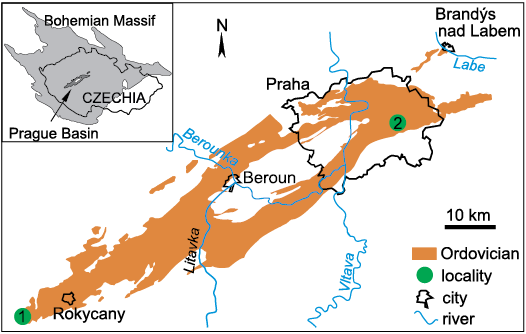
Fig. 1. Map of Ordovician rocks of the Prague Basin and position of the localities, from which the two studied specimens originate: Locality 1, Březová Hůrka near Starý Plzenec; Locality 2, Praha-Štěrboholy. Modified from Manda (2008).
The second specimen (NM L 63626) is an isolated, undeformed internal mould of a phragmocone comprised of a brown-red pelosiderite. It was collected by the private collector Miloš Chaloupka (Prague, Czech Republic) around the year 1994 in Praha-Štěrboholy (Fig. 1: Locality 2). The specimen originated from silty shales excavated for the construction of a shopping centre (northeast of the intersection of the Prague ring motorway with the Průmyslová Street). The shale beds were assigned to the upper Zahořany Formation (lower Katian; Upper Ordovician; Fig. 2) based on the characteristic lithology, as well as the common occurrence of the cystoid Aristocystites bohemicus Barrande, 1887, represented mainly by the massive basal portions.
The specimens were studied under a binocular microscope and measured to obtain standard shell parameters of Korn (2010) (Fig. 3, Table 1). The distance of septa is expressed as the relative cameral length (Pohle et al. 2022) and calculated as cameral length vs. whorl height (RCL = cl/wh). The size of the siphuncle is expressed as the relative septal foramen height (Pohle et al. 2022) and calculated as the height of the septal foramen vs. whorl height (RSH = fh/wh).
Both specimens were coated in ammonium chloride prior to photography. Photographing was performed using a SONY ILCE-7RM3 camera. NM L 63626 was scanned using the micro-tomograph SkyScan 1172 and the shell reconstructed with N-Recon software; final photographs were then prepared in the Avizo 9.1.1. software. Detailed images of shell ornament in NM L 63626 were made with a Hitachi S-3700N scanning electron microscope.
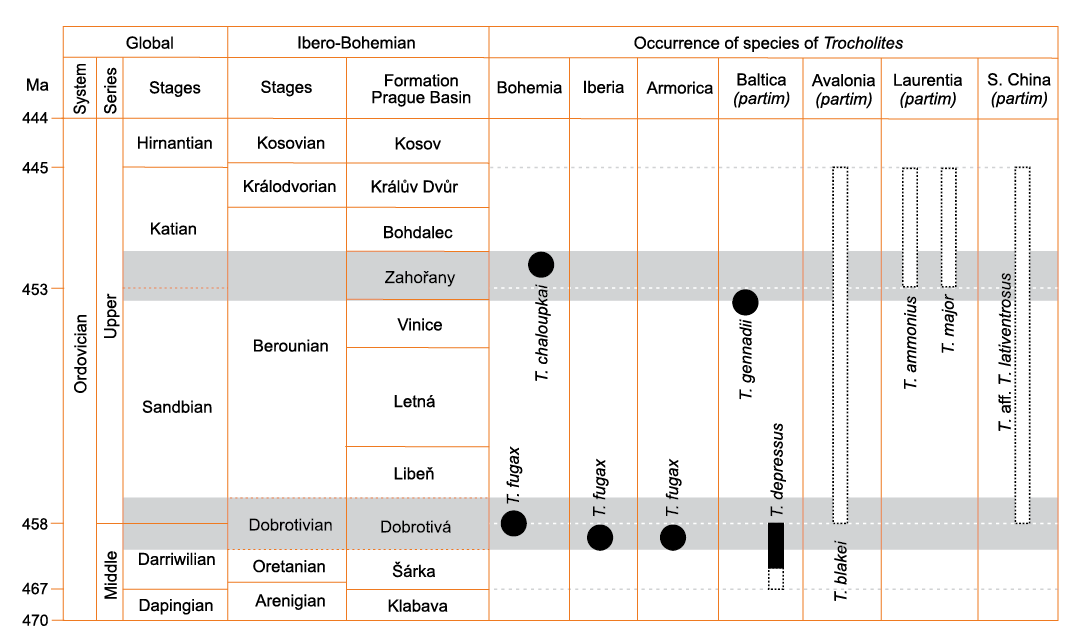
Fig. 2. Correlation of the Dobrotivá and Zahořany formations (greyed-out levels) with global and Ibero-Bohemian chronostratigraphic units, and the herein discussed occurrence of Trocholites. Modified from Kraft et al. (2015), Fatka and Budil (2022), and Kraft et al. (2023).
Geological settings
The majority of Ordovician sediments in the Czech Republic occur in the Barrandian area of the Teplá-Barrandian Unit (central Bohemia). There, a denudation relict of a narrow, linear, tectonically predisposed, rift-type basin is preserved, which is termed the Prague Basin. The sedimentation in this basin started with opening of the Rheic ocean in the Tremadocian (Early Ordovician) and terminated with the onset of the Variscan orogeny in the Givetian (Middle Devonian). The lithology of the Prague Basin infilling gradually changes from prevailingly clastic (Ordovician) to carbonate rocks (upper Silurian–lower Middle Devonian), reflecting drift of peri-Gondwanan terrains from high palaeolatitudes towards the palaeoequator; the sedimentation was accompanied with volcanic activity in multiple intervals. The generally continuous, unmetamorphosed and richly fossiliferous marine rock succession of the Prague Basin is among the most classical and best studied globally with several global stratotypes established in the upper Silurian and Devonian part of the succession. For summary and references on the development of the Prague Basin see Havlíček in Chlupáč et al. (1998), Vacek and Žák (2019) and Kraft et al. (2023).
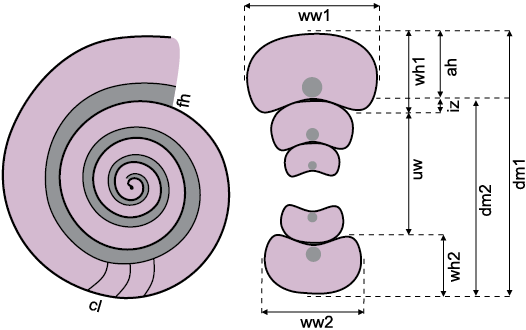
Fig. 3. Parameters used to measure and describe the specimens studied herein (after Korn 2010). Abbreviations: ah, apertural height; cl, cameral length; dm, shell diameter across centre of umbilicus; fh, foramen height; iz, imprint zone; uw, umbilical width; wh, whorl height; ww, whorl width. Line drawings are based on NM L 63626 (holotype of Trocholites chaloupkai sp. nov.).
Table 1. Measurements (in mm) of the two trocholitid specimens studied herein. Ratios from Korn (2010). In bold are the main coiling parametres of Korn (2010). Abbreviations: ah, apertural height; cl, chamber length; dm, shell diameter across centre of umbilicus; fh, foramen height; iz, imprint zone; uw, umbilical width; ww, whorl width. CWI, conch width index; dm, shell diameter across centre of umbilicus; fh, foramen height; iz, imprint zone; IZR, imprint zone rate; uw, umbilical width; RCL, relative cameral length; RSH, relative septal foramen height; UWI, umbilical width index; WER, whorl expansion rate calculated based on either whorl height (WERwh) or aperture height (WERah); wh, whorl height; ww, whorl width; WWI, whorl width index.
|
Taxonomy |
Coll. no. |
dm1 |
dm2 |
ww1 |
ww2 |
wh1 |
wh2 |
WWI |
uw |
ah |
iz |
WERwh |
WERah |
IZR |
UWI |
CWI |
fh |
RSH |
fh/ah |
cl |
RCL |
|
Trocholites chaloupkai |
NM L 63626 |
23.3 |
17.6 |
11.5 |
8.9 |
6.9 |
5.2 |
1.67 |
11.2 |
5.7 |
1.2 |
2.01 |
1.75 |
0.17 |
0.48 |
0.49 |
1.6 |
0.23 |
0.28 |
2.2 |
0.33 |
|
17.6 |
13.3 |
8.9 |
6.8 |
5.2 |
4.2 |
1.70 |
8.2 |
4.3 |
0.9 |
2.03 |
1.76 |
0.17 |
0.47 |
0.51 |
1.1 |
0.21 |
0.25 |
|
|
||
|
13.3 |
9.9 |
6.8 |
|
4.2 |
|
1.63 |
|
3.4 |
0.8 |
2.13 |
1.80 |
0.19 |
|
0.51 |
|
|
|
|
|
||
|
Trocholites fugax |
NM L 63625 |
30.5 |
21.8 |
|
|
11.9 |
8.7 |
|
9.9 |
8.7 |
3.2 |
2.70 |
1.96 |
0.27 |
0.32 |
|
|
|
|
2.7 |
0.28 |
|
21.8 |
|
|
|
8.7 |
5.8 |
|
7.2 |
|
|
2.78 |
|
|
0.33 |
|
|
|
|
|
|
Ordovician strata of the Prague Basin are divided in twelve formations. Their lithology and fossil content reflect the opening and deepening of the sedimentary basin associated with the interplay between global changes including eustasy, and local volcanic and synsedimentary tectonic activity and changing palaeogeographic position of the region. The rocks of the Dobrotivá Formation were formed during the Middle/Late Ordovician boundary interval (late Darriwilian and earliest Sandbian; Fig. 2). The succession consists of the relatively deeper-water black shale and the shallow-water sandy deposits. Body fossils are best preserved in carbonatic nodules within the shelly facies. Meanwhile, they are usually rare in the sandy facies, which, however, contain common ichnofossils. For summary and further discussion on the lithology, depositional conditions, stratigraphy and faunal assemblages of the Dobrotivá Formation, see Havlíček and Vaněk (1996), Mikuláš (1998), Havlíček in Chlupáč et al. (1998), Fatka and Mergl (2009) and Fatka and Vodička (2022).
Cephalopod assemblages of the Dobrotivá Formation consist mainly from straight-shelled orthoceratoids attributable to species of the orders Orthoceratida and Pseudorthoceratida (Marek 1999; Manda 2008; Aubrechtová 2015; Aubrechtová et al. 2020); rare are the representatives of the Lituitida (Aubrechtová and Turek 2018) and Tarphyceratida (Manda 2008).
The stratigraphically younger, late Sandbian–early Katian (Fig. 2), Zahořany Formation is preserved mainly in the central part of the Prague Basin. The succession is formed mostly by rather monotonous siltstone beds, which only rarely contain intercalations of silty sandstone and silty shale. The siltstone beds often have carbonate cement, locally developed are nodules and lenses of fossiliferous, clayish limestone. Dark grey or black shale beds of the Zahořany Formation are restricted to the central, deepest part of the basin. For further details on the lithology, depositional conditions, stratigraphy and faunal assemblages of the Zahořany Formation, see Mikuláš (1998), Havlíček in Chlupáč et al. (1998), Fatka and Mergl (2009), Ernst et al. (2014), and Fatka and Budil (2022).
The cephalopods of the Zahořany Formation belong to the orders Orthoceratida and Pseudorthoceratida (Marek 1999); the below studied specimen of Trocholites is the only coiled cephalopod known to date from the Zahořany Formation.
Systematic palaeontology
Class Cephalopoda Cuvier, 1797
Subclass: Multiceratoidea Mutvei, 2013
Order Tarphyceratida Flower in Flower and Kummel, 1950
Family Trocholitidae Chapman, 1857
Genus Trocholites Conrad, 1838
Type species: Trocholites ammonius Conrad, 1838, by original designation; Upper Ordovician, Trenton Limestone, New York, USA.
Trocholites fugax Babin and Gutiérrez-Marco, 1992
Fig. 4.
?1865 Lituites primulus Barr.; Barrande 1865: pl. 99: 12.
1992 Trocholites fugax n. sp.; Babin and Gutiérrez-Marco 1992: 530–534, figs. 3a–h, 4a–f.
?1992 Lituites primulus; Babin and Gutiérrez-Marco 1992: 534.
1996 Trocholites fugax; Babin et al. 1996: 107, pl. 1: 1–3.
1996 “cyrtokonní nautiloid”; Mergl 1996: 23.
1999 “Lituites” primulus Barrande; Vaněk 1999: 8.
?1999 Curtoceras primulus; Marek 1999: 415, 416.
2008 Trocholites fugax Babin and Gutiérrez-Marco, 1992; Manda 2008: 330–332, fig. 3.
2009 Trocholites fugax Babin and Gutiérrez-Marco; Sá and Gutiérrez-Marco 2009: 9–12, fig. 2A, B.
2010 Trocholites fugax Babin and Gutiérrez-Marco, 1992; Rábano et al. 2010: 420.
2013 Trocholites fugax Babin and Gutiérrez-Marco, 1992; Evans et al. 2013: 28.
2015 Trocholites fugax Babin and Gutiérrez-Marco, 1992; Aubrechtová 2015: 208.
2018 Trocholites fugax Babin and Gutiérrez-Marco, 1992 (= ?Lituites primulus Barrande, 1865); Aubrechtová and Turek 2018: 402.
Material.—Single specimen NM L 63625a, b from the locality Březová Hůrka near Starý Plzenec (Fig. 1: Locality 1), middle to uppermost Dobrotivá Formation (upper Darriwilian–lower Sandbian, Middle–Upper Ordovician).
Description.—NM L 63625 is 31 mm in diameter with two outer whorls preserved; the inner whorls and at least the adapertural 90° of the body chamber are missing (as indicated by remains of umbilical seams on the surface of the last preserved whorl). At the maximum diameter, the shell is subevolute (UWI = 0.32), with the last whorl moderately impressed (IZR ~0.27 at dm = 31 mm) and moderately expanded (WER based on apertural height ~1.96 at dm = 31 mm). The relative cameral length (RCL) is about 0.30 in the outer whorl (chambers moderately long). The sutures form a low lobe ventrally and are slightly sinuous on the flanks. There are no traces of the shell ornament apparent on either the internal or external moulds of the specimen.
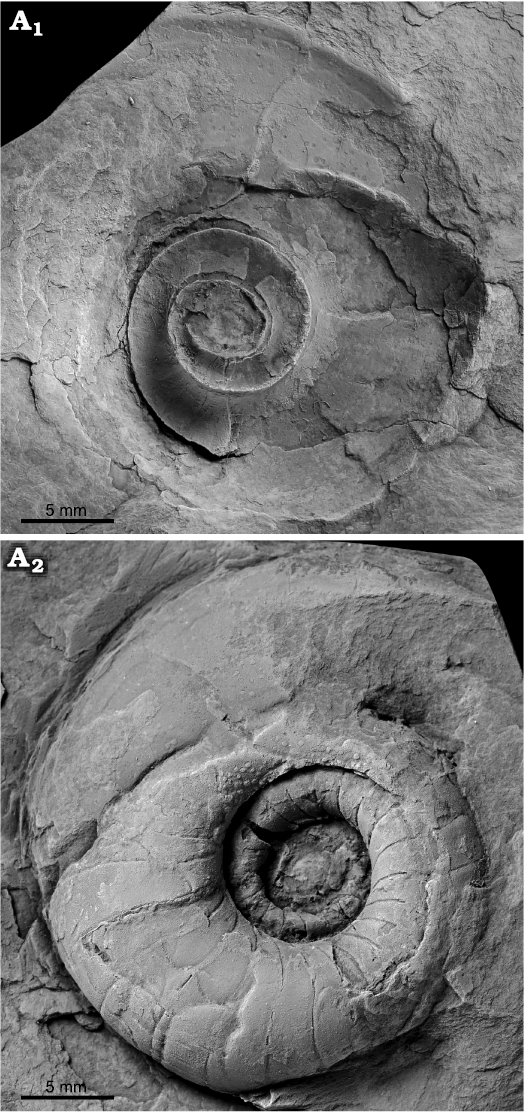
Fig. 4. Tarphyceratid cephalopod Trocholites fugax Babin and Gutiérrez-Marco, 1992, from Březová Hůrka near Starý Plzenec, central Bohemia, Czech Republic, Dobrotivá Formation (upper Middle–lower Upper Ordovician). A. NM L 63625a, b, counterpart (A1) and part (A2).
Remarks.—The internal mould of the body chamber, especially the umbilical wall, shows numerous circular or semi-circular structures (0.2–0.3 mm in diameter). The structures are herein interpreted as abiotic.
Trocholites fugax was earlier described by Babin and Gutiérrez-Marco (1992), Babin et al. (1996) and Sá and Gutiérrez-Marco (2009) from the Dobrotivian (upper Darriwilian) of southern Europe. Later, Manda (2008) reported the species from the Prague Basin. Based on new information (Michal Mergl, personal communication 2023), the specimens described by Manda (2008) originate from the upper or uppermost part of the Dobrotivá Formation (uppermost Darriwilian or lowermost Sandbian). Minor differences in shell morphology between the specimens studied by Manda (2008) and other representatives of T. fugax including NM L 63625 (submarginal siphuncle, lower expansion rate, apparently uncoiled body chamber) are herein interpreted as resulting from the deformation and breakage of the former specimens, or alternatively minor intraspecific variation.
The representatives of T. fugax differ from NM L 63626 (here assigned to T. chaloupkai sp. nov.) in the greater expansion rate (WER based on whorl height = 2.78 vs. 2.00; dm ~22 mm), narrower umbilicus (UWI = 0.33 vs. 0.48; dm ~22 mm) and less sinuous (vs. sinuous) suture lines.
Stratigraphic and geographic range.—Upper Middle–lower Upper Ordovician, Iberian Peninsula (Portugal and Spain), Armorican Massif (France), central Bohemia (Czech Republic); Dobrotivian Regional Stage.
Trocholites chaloupkai sp. nov.
Figs. 5–7.
Zoobank LSID: urn:lsid:zoobank.org:act:0F372BB0-E1D8-4895-9ECA-1A6FCD830A10
Etymology: Named after Miloš Chaloupka, who collected the holotype.
Holotype: NM L 63626, moderately preserved phragmocone with shell remains, undeformed but incomplete adaperturally.
Type locality: Praha-Štěrboholy, central Bohemia, Czech Republic.
Type horizon: Upper Zahořany Formation, lower Katian, Upper Ordovician.
Material.—Holotype only.
Diagnosis.—Trocholites with evolute, thickly discoidal shell (UWI = 0.50, CWI = 0.50), moderately expanding (WER = 1.80) in later whorls; whorl profile depressed (WWI = 1.70), moderately impressed (IZR = 0.17); at the beginning of the last whorl ventrally slightly flattened and laterally rounded. Siphuncle marginodorsal in inner whorls and very slightly removed from the dorsal shell wall in the last 0.50 whorl; septal foramen height ~0.23 of corresponding whorl height at shell diameter ~23 mm. Sutures with rounded ventral lobe, rounded ventro-lateral saddle and shallow lateral lobe. Shell ornament consisting of fine transverse elements forming a net-like (fenestrate) pattern.
Description.—The holotype NM L 63626 is a phragmocone 26 mm in diameter. It consists of four whorls but scars representing remains of the umbilical seams indicate the former presence of at least one more whorl (Fig. 5A1). The micro-CT images show the embryonic shell and the small, drop-shaped umbilical window (~0.5 mm in diameter) (Figs. 5A8, 6, SOM 1, 2, Supplementary Online Material available at http://app.pan.pl/SOM/app68-Aubrechtova_etal_SOM.pdf). In the last preserved whorl (dm = 13–23 mm), the shell is thickly discoidal (CWI = 0.51–0.49) and evolute (UWI = 0.47–0.48), while the whorl expansion rate slowly decreases (WER = 1.80–1.75). The whorl profile is moderately impressed (IZR = 0.19–0.17) and moderately depressed (WWI changes from 1.63 to 1.70 and to 1.67, respectively) with slightly flattened ventral side and rounded flanks (Fig. 5A5, A6; SOM 1, 2). The siphuncle is in contact with the dorsal shell wall in inner whorls and slightly removed from it in the last half a whorl (Figs. 5, 6; SOM 1, 2); it is of medium size (RSH = 0.23 at wh = 6.9 mm; fh/ah = 0.30 at the same wh). The phragmocone chambers are moderately long (RCL = 0.33 at wh = 7 mm) (Fig. 5A4, A7; SOM 1, 2). The sutures extend into a rounded ventral lobe, a pronounced, rounded ventro-lateral saddle and a shallow lateral lobe (Fig. 5A2, A3). The shell ornament is comprised of transverse elements that are organised in a fine, net-like (fenestrate) pattern (Fig. 7). The transverse elements of the ornament are slightly inclined (steeper side oriented adaperturally) and sinuous; neighbouring elements merge at more or less regular intervals so that apparent longitudinal organisation is formed.
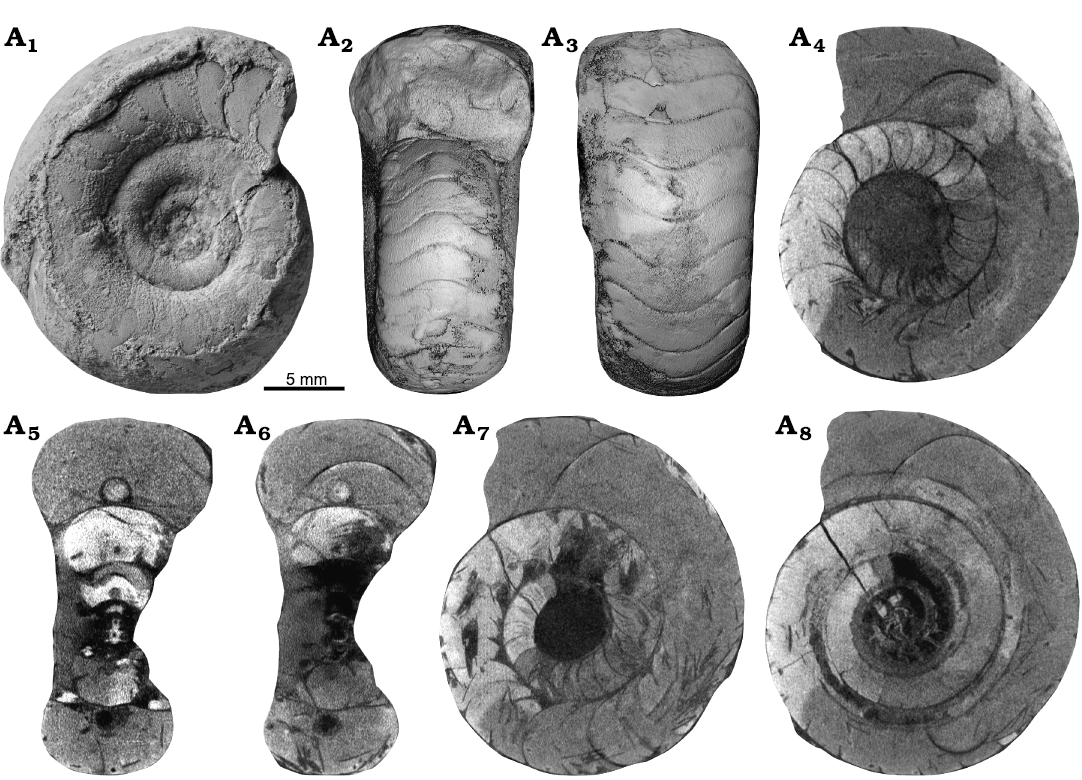
Fig. 5. Tarphyceratid cephalopod Trocholites chaloupkai sp. nov. from Praha-Štěrboholy, central Bohemia, Czech Republic, upper part of the Zahořany Formation (lower Katian, Upper Ordovician). Holotype NM L 63626, optical microscope photograph of whitened specimen in lateral view (A1); micro-CT images showing frontal (A2) and ventral (A3) views, note ventral lobe of suture line; virtual longitudinal sections in sagittal plane showing partly preserved septa in last (A4) and penultimate (A7) whorls; virtual longitudinal section in median plane (A8) showing the siphuncle and the earliest whorl of the phragmocone; virtual transverse sections in slightly eccentric (A5) and central (A6) planes documenting whorl profile shape and siphuncle.
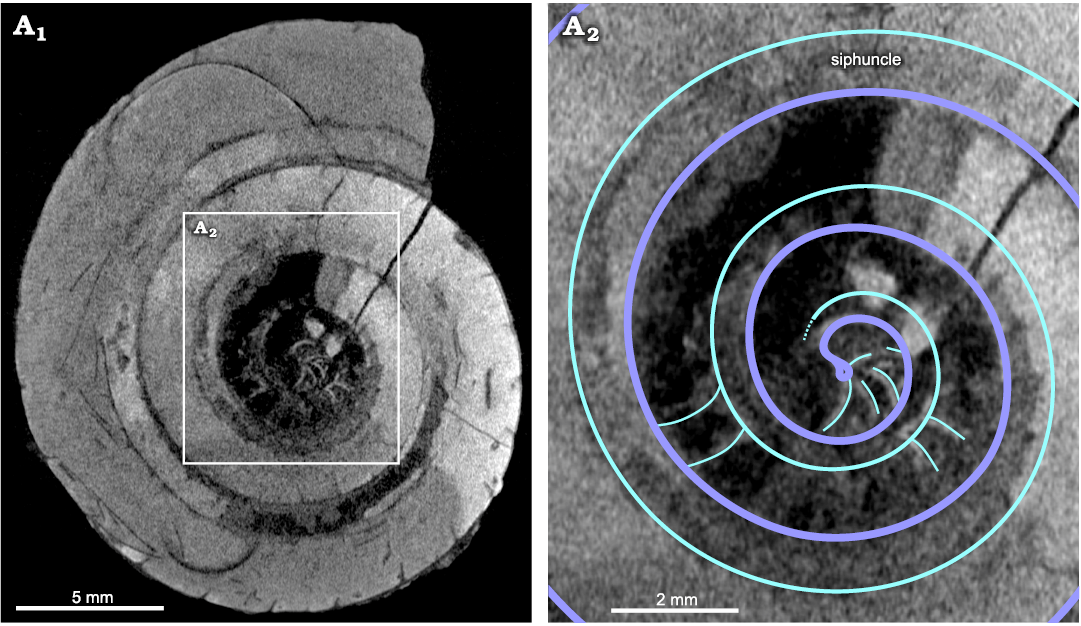
Fig. 6. Tarphyceratid cephalopod Trocholites chaloupkai sp. nov. from Praha-Štěrboholy, central Bohemia, Czech Republic, upper part of the Zahořany Formation (lower Katian, Upper Ordovician). A. Holotype NM L 63626, detail of apicalmost part of the phragmocone (A1) and drawing (A2) indicating line of contact of whorls, position of siphuncle, position of (partly fragmented) septa and shape of initial chamber and umbilical window.
Remarks.—The holotype NM L 63626 has a unique, finely fenestrate shell ornament. The ornament might represent remains of crenulate elements similar to those known in the species of Dawsonoceras (Kröger and Isakar 2006), Discoceras (Manda and Turek 2018; Kröger and Aubrechtová 2018) or Glyptodendron (Evans et al. 2015). However, in the holotype of Trocholites chaloupkai sp. nov., the widest points of the cell-like structures are offset from each other by half of a wavelength and in contact at these points (David H. Evans, personal communication 2023). Most similar to that is the shell ornament previously figured and discussed in specimens of T. ammonius Conrad, 1838, and T. major Ruedemann, 1926, from the Upper Ordovician of North America (see also Hall 1847 and Hyatt 1894). However, these specimens differ from the holotype of T. chaloupkai sp. nov. in having nearly straight suture line and siphuncle located in the middle between the centre of the shell and its dorsal wall.
Ventral lobe of suture line appears to be present in the holotype of Trocholites blakei Hyatt, 1894, from the Upper Ordovician Bala Series of Great Britain. Original figure of Blake (1882) shows that the specimen might also have similar WER as the holotype of T. chaloupkai sp. nov. However, too little is known about the holotype and single described specimen of T. blakei to make a reliable comparison with T. chaloupkai sp. nov. .
The specimen from the Upper Ordovician of Yunnan (SW China), classified by Zhang and Chen (2002) as Trocholites aff. Trocholites lativentrosus Lai and Wang in Wang, 1981, appears to have a nearly identical conch geometry and whorl profile to the holotype of T. chaloupkai sp. nov. However, the former specimen differs in shell ornament—it has simple lirae on the shell surface.
Among the Trocholites species from Baltica, the holotype of T. chaloupkai sp. nov. is nearly identical in shell geometry to the representatives of T. depressus (Eichwald, 1840) from the Darriwilian (Middle Ordovician) of Estonia (Balashov 1953; Kröger and Keupp 2004; Martina Aubrechtová and Dieter Korn, MS unpublished material). However, the ventral surface of the shell of the new species is slightly flattened and associated with the development of ventrolateral saddles and a ventral lobe; by contrast, suture lines are nearly straight or with a very low ventral saddle in Trocholites depressus.
The holotype of Trocholites chaloupkai sp. nov. differs from the holotype of the stratigraphically slightly older (late Sandbian) T. gennadii Kröger and Aubrechtová, 2018, from Estonia in the shape of whorl profile (ventrally flattened vs. rounded) and shape of suture lines (sinuous vs. straight).
The holotype of Trocholites chaloupkai sp. nov. is distinguished from the representatives of the other species reported from Ordovician rocks of peri-Gondwana, T. fugax by its lower expansion rate (WER based on wh = 2.01 vs. 2.22–2.82 at dm ~23 mm) which decreases adaperturally, its wider umbilicus (UWI = 0.48 vs. 0.36 at dm ~23 mm) and its smaller imprint zone (IZR = 0.17 vs. 0.34 at dm ~23 mm). Also, the suture line of the new species is more sinuous (vs. nearly straight in T. fugax) with a pronounced ventral lobe.
Stratigraphic and geographic range.—Type horizon and locality only.
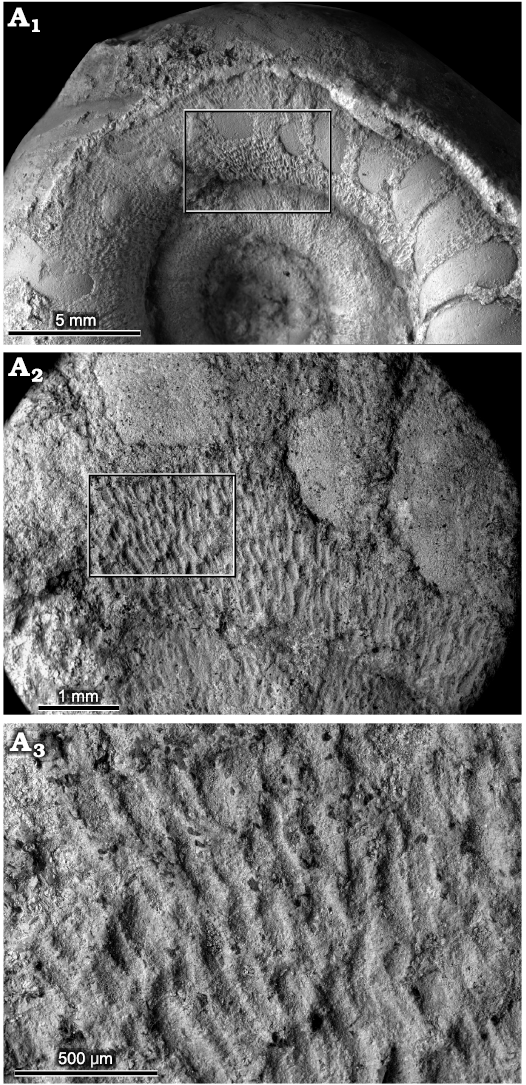
Fig. 7. Tarphyceratid cephalopod Trocholites chaloupkai sp. nov. from Praha-Štěrboholy, central Bohemia, Czech Republic, upper part of the Zahořany Formation (lower Katian, Upper Ordovician). A. Holotype NM L 63626, general view on shell ornament (A1); SEM image of shell ornament (A2) on umbilical wall of the outer whorl, coalescent ornament elements form a net-like (fenestrate) pattern; SEM image with detail of shell ornament (A3), transverse elements have a lamellar character and are imbricated adaperturally, the elements form undulating ridges that are locally coalescent with each other.
Discussion
Cephalopod assemblages in the Ordovician of the Prague Basin are mostly composed of indeterminable orthoconic cephalopods, the majority of which probably belong to the orders Orthoceratida Kuhn, 1940, and Pseudorthoceratida Flower and Caster, 1935. More diverse assemblages are known only from some restricted intervals, such as the Klabava, Šárka, and Dobrotivá formations (Dapingian–Darriwilian, Middle Ordovician) and the Králův Dvůr Formation (upper Katian–lowermost Hirnantian, Upper Ordovician). Some extremely rare elements occur in these intervals, which are otherwise known from distant palaeocontinents, especially Baltica (e.g., Marek 1999; Manda 2008; Aubrechtová 2015; Aubrechtová and Turek 2018; Aubrechtová and Turek 2023). These include particularly lituitid, actinoceratid, endoceratid, and oncoceratid cephalopods and the herein discussed tarphyceratid cephalopods of of the genus Trocholites.
Only about a dozen specimens attributable to Trocholites have been collected in the Prague Basin since the time of Barrande (1865) and most of them were described and evaluated by Manda (2008). In the present study, we extend the knowledge on these palaeobiogeographically important cephalopods by describing two well-preserved specimens, which we assign to the species Trocholites fugax and T. chaloupkai sp. nov.
Trocholites fugax was originally described by Babin and Gutiérrez-Marco (1992) (see also Babin et al. 1996 and Sá and Gutiérrez-Marco 2009) from the upper Middle Ordovician strata of Armorica and Iberia, and from coeval or slightly younger rocks of Bohemia (Manda 2008). The specimen NM L 63625 (Fig. 4) further confirms the presence of the species in the Ordovician of the Prague Basin and strengthens the hypotheses on faunal interchange between Baltica and peri-Gondwana during the late Darriwilian–early Sandbian times. Other cephalopods in the Dobrotivá Formation indicating these relationships are the lituitids Lituites lituus Montfort, 1808, Trilacinoceras cf. discors (Holm, 1891) (see Aubrechtová and Turek 2018), and the orthoceratoid Bactroceras sp. (Aubrechtová et al. 2020). It is noteworthy that these migrations were not unidirectional. Warm-water elements such as tarphyceratids spread from low to high palaeolatitudes during occasional dispersion events. But for other cephalopods, such as orthoceratoids, the story was different; these originated in the high palaeolatitudes already during the Early Ordovician and gradually expanded towards the palaeoequator, becoming common components of warm-water assemblages during the Middle and Late Ordovician (Kröger et al. 2009; Kröger and Evans 2011; Kröger 2013; Aubrechtová 2015).
The holotype of T. chaloupkai sp. nov. (NM L 63626, Figs. 5, 6) from the lower Katian part of the Zahořany Formation represents the first record of tarphyceratids in the Upper Ordovician of the Prague Basin. The non-destructive micro-CT scanning has not been previously applied on Ordovician cephalopods (SOM 1, 2), with the exception of a specimen mentioned by Kouraiss et al. (2019) and preliminary results of a study presented by Aubrechtová and Turek (2023). It was shown by the latter works, as well as by the present investigation, that the micro-CT has potential to reveal internal shell structures in certain Ordovician body fossils, where the shell and internal structures would be destroyed using standard sectioning and polishing. Besides that replacing two-dimensional sections with three-dimensional virtual models brings substantial new data on the geometry, organisation and growth of septa, siphuncle and cameral and endosiphuncular deposits (Aubrechtová and Turek 2023).
The investigation showed that the holotype of T. chaloupkai sp. nov. is nearly identical in shell geometry to representatives of Trocholites depressus from the upper Darriwilian (Middle Ordovician) of Estonia (Kröger and Keupp 2004; Martina Aubrechtová and Dieter Korn, MS unpublished material) but differs in the shape of the whorl profile, course of suture lines and shell ornament. Very similar to the holotype of T. chaloupkai sp. nov. is also a specimen classified as Trocholites aff. Trocholites lativentrosus from the Upper Ordovician of southwest China (Zhang and Chen 2002), which differs only in the type of shell ornament (simple lirae).
Havlíček et al. (1994), Havlíček (1998) and Fatka and Mergl (2009) concluded that there must have been an effective barrier against faunal interchange between high and low palaeolatitudes during the Berounian (i.e., Sandbian–Katian; Late Ordovician). Indeed, the composition of the benthic fauna of the Zahořany Formation shows similarities to assemblages from other areas of peri-Gondwana and Gondwana, such as Morocco, Spain (Dastanpour et al. 2006; Nardin 2007; Ebbestad et al. 2019; Nohejlová and Lefebvre 2022) and Bolivia (Benedetto 2013). The cephalopods of the Zahořany Formation consist of taxonomically unrevised, straight shelled cephalopods with central-subcentral siphuncle, which have been suggested to be similar to the assemblages from Iran (Dastanpour et al. 2006; Ghavidel-Syooki et al. 2015). The newly described single specimen of T. chaloupkai sp. nov. is thus the only nektonic element (Westermann 1998) indicating some connections between the Prague Basin and lower palaeolatitudes during the Sandbian–Katian boundary interval. It also belongs among the stratigraphically youngest Ordovician Trocholites from peri-Gondwana and Gondwana.
Conclusions
Two well-preserved tarphyceratid specimens assigned to the species Trocholites fugax and T. chaloupkai sp. nov. are described from the Middle and Upper Ordovician of the Prague Basin. Their occurrence implies faunal interchange between the high palaeolatitude peri-Gondwana and the low palaeolatitude regions, especially Baltica, during the late Darriwilian–early Sandbian and late Sandbian–early Katian times.
Trocholites chaloupkai sp. nov. is the first tarphyceratid species described from the Upper Ordovician of Bohemia. The single specimen was studied using the non-destructive micro-CT scanning, which has not been extensively applied to Ordovician cephalopods before. The method enabled a 3D study of shell geometry, septa and siphuncle, and morphological changes during ontogeny.
Acknowledgements
We thank Miloš Chaloupka (Prague, Czech Republic), who kindly provided one of the specimens for study herein. We are indebted to Zuzana Heřmanová and Jana Bruthansová (both NM) for technical help with micro-CT scanning and reconstruction. Lenka Váchová (NM) is acknowledged for photographing the herein described material. Michal Mergl (University of West Bohemia, Plzeň, Czech Republic) is thanked for helpful consultations on the stratigraphic age of the Dobrotivian specimens of Trocholites fugax. We would also like to thank the two reviewers, David H. Evans (Natural England, Bridgwater, UK) and Alexander Pohle (Ruhr-University, Bochum, Germany), for their constructive and helpful comments improving the quality of the manuscript. MA was supported by the Center for Geosphere Dynamics of the Charles University Prague (UNCE/SCI/006) and the Research Plan of the Institute of Geology of the Czech Academy of Sciences (RVO67985831). VT was supported by the Ministry of Culture of the Czech Republic (IP DKRVO 2019-2023/2.IV.e, National Museum, 00023272). ŠM was funded by the Strategic Research Plan of the Czech Geological Survey (DRKVO/ČGS 2023–2027, Internal Project no. 311410). This paper is a contribution to IGCP project 735 “Rocks and the Rise of Ordovician Life: Filling knowledge gaps in the Early Palaeozoic Biodiversification”.
References
Aubrechtová, M. 2015. A revision of the Ordovician cephalopod Bactrites sandbergeri Barrande: systematic position and palaeobiogeography of Bactroceras. Geobios 48: 193–211. Crossref
Aubrechtová, M. and Turek, V. 2018. Lituitid cephalopods from the Middle Ordovician of Bohemia and their paleobiogeographic affinities. Bulletin of Geosciences 93: 401–417. Crossref
Aubrechtová, M. and Turek, V. 2023. Three-dimensionally preserved siphuncle in an actinoceratid cephalopod from the late Katian of Bohemia. Estonian Journal of Earth Sciences 72: 119. Crossref
Aubrechtová, M., Turek, V., and Zicha, O. 2020. Early ontogenetic growth stages of Middle Ordovician orthoceratoid cephalopods from Bohemia. Acta Palaeontologica Polonica 65: 575–588. Crossref
Babin, C. and Gutiérrez-Marco, J.C. 1992. Intérêt paléobiogéographique de la présence du genre Trocholites (Cephalopoda, Nautiloidea) dans le Dobrotivá (Llandeilo) inférieur d’Espagne. Neues Jahrbuch für Geologie und Paläontologie, Monatshefte 1992 (9): 519–541. Crossref
Babin, C., Becq-Giraudon, J.F., Lardeux, H., and Gutiérrez-Marco, J.C. 1996. Présence de Trocholites (Cephalopoda, Nautiloidea) dans L’Ordovicien du Massif Armoricain et du Portugal. Bulletin de la Société des Sciences de l’Ouest de la France, nouvelle série 18 (3): 105–112.
Balashov, Z.G. [Balašov, Z.G.] 1953. Coiled and semicoiled Nautiloidea from the Ordovician of the Baltic area [in Russian]. Trudy Vsesoûznogo Neftânogo Naučno-Issledovatel’skogo Geologo-Razvednoknogo Instituta 78: 217–300.
Barrande, J. 1865. Systême Silurien du centre de la Bohême, Iére partie: Recherches Paléontologiques, vol. II., Classe de Mollusques, Ordre des Céphalopodes. 1ére Série: Planches 1 à 107. 107 pp. Chez l’auteur et éditeur, Prague.
Barrande, J. 1887. Systême Silurien du centre de la Bohême, Iére partie: Recherches Paléontologiques. Vol. VII, Classe des Echinodermes, Ordre des Cystidées: Texte et 39 Planches. 233 pp. Fr. Řivnáč, Prague.
Benedetto, J.L. 2013. Upper Ordovician brachiopods from the San Benito Formation, Cordillera del Tunari, Bolivia. Ameghiniana 50: 418–428. Crossref
Blake, J.F.A. 1882. A Monograph of the British fossil Cephalopoda, Part 1, Introduction and Silurian species. 248 pp. J. van Voorst, 1 Paternoster Row, London. Crossref
Chapman, E.J. 1857. On the occurrence of the genus Cryptoceras in Silurian rocks. Canadian Journal, New Series 2: 264–268.
Chlupáč, I., Havlíček, V., Kříž, J. Kukal, Z., and Štorch, P. 1998. Palaeozoic of the Barrandian (Cambrian to Devonian). 183 pp. Czech Geological Survey, Prague.
Cocks, L.R.M. and Torsvik, T.H. 2021. Ordovician palaeogeography and climate change. Gondwana Research 100: 53–72. Crossref
Conrad, T.A. 1838. Report on the Palaeontological Department of the Survey (New York). New York State Geological Survey, Annual Report 2: 107–119.
Cuvier, G. 1797. Tableau élémentaire de l’histoire naturelle des animaux. 710 pp. Baudoin, Paris. Crossref
Dastanpour, M., Evans, D.H., and Bassett, M.G. 2006. A new orthoceratoid cephalopod from the Ordovician (Caradoc) of east-central Iran. Geobios 39: 337–345. Crossref
Ebbestad, J.O., Polechová, M., Kröger, B., and Gutiérrez-Marco, J.C. 2019. Late Ordovician molluscs of the central and eastern Anti-Atlas, Morocco. Geological Society, London, Special Publications 485: 237–296. Crossref
Eichwald, E. 1840. Ueber das silurische Schichtensystem in Esthland. Zeitschrift für Natur- und Heilkunde Medizinische Akademie zu St. Petersburg 1–2: 1–210. Crossref
Ernst, A., Kraft, P., and Zágoršek, K. 2014. Trepostome bryozoans from the Zahořany Formation (Upper Ordovician) of Loděnice, Prague Basin, Czech Republic. Paläontologische Zeitschrift 88: 11–26. Crossref
Evans, D.H. 2000. A cephalopod fauna from the Middle Ordovician of Saudi Arabia. Palaeontology 43: 573–589. Crossref
Evans, D.H., Ghobadi Pour, M., and Popov, L.E. 2013. Review of Early to Mid-Ordovician orthoconic cephalopods from Iran. Bulletin of Geosciences 88: 21–44. Crossref
Evans, D.H., Ghobadi Pour, M., Popov, L.E., and Jahangir, H. 2015. An Early Silurian (Aeronian) cephalopod fauna from Kopet-Dagh, north-eastern Iran: including the earliest records of non-orthocerid cephalopods from the Silurian of Northern Gondwana. Bulletin of Geosciences 90: 479–507. Crossref
Fatka, O. and Budil, P. 2022. Contribution of August Heinrich Ernst Beyrich to the knowledge of Ordovician trilobites in the Czech Republic. Paläontologische Zeitschrift 96: 669–687. Crossref
Fatka, O. and Mergl, M. 2009. The „microcontinent“ Perunica—status and story 15 years after its conception. Geological Society, London, Special Publications 325: 65–101. Crossref
Fatka, O. and Vodička, J. 2022. Putative Ordovician green alga Krejciella reinterpreted as enteropneust hemichordate tube (Czech Republic). Palaeontologia Electronica 25 (2): a25. Crossref
Flower, R.H. and Caster, K.E. 1935. The cephalopod fauna of the Conewango Series of the Upper Devonian in New York and Pennsylvania. Bulletin of American Paleontology 22: 1–74.
Flower, R.H. and Kummel, B. 1950. A classification of the Nautiloidea. Journal of Paleontology 24: 604–616.
Ghavidel-Syooki M., Evans, D.H., Ghobadi Pour, M., Popov, L.E., Álvaro, J.J., Rakhmonov, U., Klishevich, I.A., and Ehsani, M.H. 2015. Late Ordovician cephalopods, tentaculitides, machaeridians and echinoderms from Kuh-e Faraghan, High Zagros, Iran. Alcheringa: An Australasian Journal of Palaeontology 39: 530–549. Crossref
Hall, J. 1847. Natural history of New York, Paleontology, vol.1, containing descriptions of the organic remains of the lower division of the New-York system (equivalent of the Lower Silurian rocks of Europe). 338 pp. Van Benthuysen & New York Geological Survey, New York.
Havlíček, V. 1998. Ordovician. In: I. Chlupáč, V. Havlíček, J. Kříž, Z. Kukal, and P. Štorch (eds.), Palaeozoic of the Barrandian (Cambrian to Devonian), 41–78. Czech Geological Survey, Prague.
Havlíček, V. and Vaněk, J. 1996. Dobrotivian/Berounian boundary interval in the Prague Basin with a special emphasis on the deepest part of the trough (Ordovician, Czech Republic). Věstník Českého geologického ústavu 71: 225–243.
Havlíček, V., Vaněk, J., and Fatka, O. 1994. Perunica microcontinent in the Ordovician (its position within the Mediterranean Province, series division, benthic and pelagic associations). Sborník geologických věd, Geologie 46: 23–56.
Holm, G. 1891. Om mynningen Lituites. Geologiska Föreningens i Stockholm Förhandlingar 13: 736–776. Crossref
Hyatt, A. 1894. Phylogeny of an acquired characteristic. Proceedings of the American Philosophical Society 32: 349–647. Crossref
Kouraiss, K., El Hariri, K., El Albani, A., Azizi, A., Mazurier, A., and Lefebvre, B. 2019. Digitization of fossils from the Fezouata Biota (Lower Ordovician, Morocco): Evaluating computed tomography and photogrammetry in collection enhancement. Geoheritage 11: 1889–1901. Crossref
Korn, D. 2010. A key for the description of Palaeozoic ammonoids. Fossil Record 13: 5–12. Crossref
Kraft, P., Linnemann, U., Mergl, M., Bruthansová, J., Laibl, L., and Geyer, G. 2023. Ordovician of the Bohemian Massif. In: D.A.T. Harper, B. Lefebvre, I.G. Percival, and T. Servais (eds.), A Global Synthesis of the Ordovician System: Part 1. Geological Society, London, Special Publications 532: 433–464. Crossref
Kraft, P., Štorch, P., and Mitchell, C.E. 2015. Graptolites of the Králův Dvůr Formation (mid Katian to earliest Hirnantian, Czech Republic). Bulletin of Geosciences 90: 195–225. Crossref
Kröger, B. 2013. Cambrian–Ordovician cephalopod palaeogeography and diversity. In: D.A.T. Harper and T. Servais (eds.), Early Palaeozoic Biogeography and Palaeogeography. Geological Society, London, Memoirs 38: 429–448. Crossref
Kröger, B. and Aubrechtová, M. 2018. Cephalopods from reef limestone of the Vasalemma Formation, northern Estonia (latest Sandbian, Upper Ordovician) and the establishment of a local warm-water fauna. Journal of Systematic Palaeontology 16: 799–839. Crossref
Kröger, B. and Evans, D.H. 2011. Review and palaeoecological analysis of the late Tremadocian–early Floian (Early Ordovician) cephalopod fauna of the Montagne Noire, France. Fossil Record 14: 5–34. Crossref
Kröger, B. and Isakar, M. 2006. Revision of annulated orthoceridan cephalopods of the Baltoscandic Ordovician. Fossil Record 9: 137–163. Crossref
Kröger, B. and Keupp, H. 2004. A paradox survival-report of a repaired syn vivo perforation in a nautiloid phragmocone. Lethaia 37: 439–444. Crossref
Kröger, B., Servais, T., and Zhang, Y. 2009. The origin and initial rise of pelagic cephalopods in the Ordovician. PLoS One 4: e7262. Crossref
Kuhn, O. 1940. Paläozoologie in Tabellen. 50 pp. Fischer Verlag, Jena.
Manda, Š. 2008. Trocholites Conrad, 1838 (Nautiloidea, Tarphycerida) in the Middle Ordovician of the Prague Basin and its palaeobiogeographical significance. Bulletin of Geosciences 83: 327–334. Crossref
Manda, Š. and Turek, V. 2018. Silurian tarphycerid Discoceras (Cephalopoda, Nautiloidea): systematics, embryonic development and paleoecology. Journal of Paleontology 92: 412–431. Crossref
Marek, J. 1999. Ordovician cephalopods of the Prague Basin (Barrandian area, Czech Republic): a review. Acta Universitatis Carolinae – Geologica 43: 413–416.
Mergl, M. 1996. Lower Ordovician in temporary outcrops along highway D5 near Mýto and Ejpovice (West Bohemia). Erica 5: 21–26.
Mikuláš, R. 1998. Ordovician of the Barrandian area: reconstruction of the sedimentary basin, its benthic communities and ichnoassemblages. Journal of Geosciences 43: 143–159.
Montfort, P.D. de 1808. Conchyliologie systématique et classification méthodique des coquilles, Tome 1. 409 pp. F. Schoell, Paris.
Mutvei, H. 2013. Characterization of nautiloid orders Ellesmerocerida, Oncocerida, Tarphycerida, Discosorida and Ascocerida: new superorder Multiceratoidea. GFF 135: 171–183. Crossref
Nardin, E. 2007. New occurrence of the Ordovician eocrinoid Cardiocystites: Palaeogeographical and palaeoecological implications. Acta Palaeontologica Polonica 52: 17–26.
Nohejlová, M. and Lefebvre, B. 2022. Late Ordovician solutan echinoderms from the Western Tafilalt, Morocco. In: A.W. Hunter, J.J. Álvaro, B. Lefebvre, P. van Roy, and S. Zamora (eds.), The Great Ordovician Biodiversification Event: Insights from the Tafilalt Biota, Morocco, 523–539. Geological Society of London, London. Crossref
Pohle, A., Kröger, B., Warnock, R., King, A.H., Evans, D.H., Aubrechtová, M., Cichowolski, M., Fang, X., and Klug, C. 2022. Early cephalopod evolution clarified through Bayesian phylogenetic inference. BMC Biology 20 (1): 1–30. Crossref
Rábano, I., Sá, A.A., Gutiérrez-Marco, J.C., and García-Bellido, D. 2010. Two more Bohemian trilobites from the Ordovician of Portugal and Morocco. Bulletin of Geosciences 85: 415–424. Crossref
Ruedemann, R. 1926. The Utica and Lorraine formations of New York Part 2 Systematic Paleontology No.2 Mollusks, Crustaceans and Eurypterids. New York State Museum Bulletin 272: 1–168.
Sá, A.A. and Gutiérrez-Marco, J.C. 2009. Middle Ordovician cephalopods from the Valongo Formation, northern Portugal. Geogaceta 47: 9–12.
Vacek, F. and Žák, J. 2019. A lifetime of the Variscan orogenic plateau from uplift to collapse as recorded by the Prague Basin, Bohemian Massif. Geological Magazine 156: 485–509. Crossref
Vandenbroucke, T.R., Armstrong, H.A., Williams, M., Paris, F., Sabbe, K., and Zalasiewicz, J.A. 2013. Late Ordovician zooplankton maps and the climate of the Early Palaeozoic Icehouse. Geological Society, London, Memoirs 38: 399–405. Crossref
Vaněk, J. 1999. Ordovician in the easternmost part of the Prague Basin (Úvaly and Brandýs areas) and its comparison with the Rokycany area (westernmost part of the basin). Palaeontologia Bohemiae 5 (2): 5–20.
Wang, M.-Q. 1981. Palaeontological Atlas of Northwest China, Xinjiang, Vol. 1. 332 pp. Geological Publishing House, Beijing.
Westermann, G.E.G. 1998. Life habits of nautiloids. In: E. Savazzi (ed.), Functional Morphology of the Invertebrate Skeleton, 263–298. John Wiley, London.
Zhang, Y.-B. and Chen, T.-E. 2002. Ordovician nautiloids from Lijiang, Yunnan, Southwest China. Acta Palaeontologica Sinica 41: 77–84.
Acta Palaeontol. Pol. 68 (3): 529–538, 2023
https://doi.org/10.4202/app.01088.2023